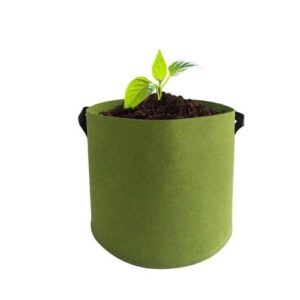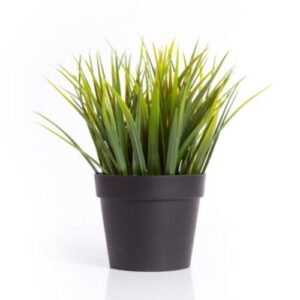You’ve probably heard of “Grow Bags” if you’re like the majority of people. They resemble something you would use to plant a plant, essentially. Your plant can grow straight up through the bottomless pot and into the air when you fill it with potting soil.
This enables you to concentrate more on the plant and less on the pot. The major debate is now: Grow bags vs Plastic Pots
Grow Bags

Grow bags are softer, more breathable versions of your beloved ceramic or plastic pots crafted from lightweight materials like polypropylene or burlap. To make lifting the bags simpler, they frequently have handles attached.
Plastic Pots
Plastic containers are far more affordable than those made of other materials thanks to the widely utilized and inexpensive production process known as injection molding. If you buy a plastic pot without drainage holes in the bottom, you may easily add them using a drill if you have access to one.
Numerous color and size options to suit your décor preferences. A wide variety of hues and circular, square, or even rectangular shapes are available.
Grow Bags Vs Plastic Pots
Potted plants are a quick and affordable approach to creating the style of garden space or indoor garden aesthetic that you have been aiming to accomplish. You might be wondering why growing bags should even be an option when they are such an affordable, quick, and simple way to incorporate plants into any area of your house and garden.
Now, for choosing, let’s get to know Grow Bags Vs Plastic Pots
Versatility
Grow bags are simple to carry from one place to another because of their small weight and built-in handles. They can be easily carried inside or outside, which is why they are particularly popular among those who drive RVs.
The best part is that they may either be planted directly into the ground since they decompose quickly and take up little space when being kept. Grow bags simply give inexperienced gardeners more alternatives and adaptability than their potted counterparts, providing them more freedom to choose how to employ plants in the home or garden.
Grow bags offer so many more benefits that it makes sense to invest the extra money even though pots are much more prevalent and undoubtedly a little more economical to use. Compared to containers, this results in healthier plants, less overwatering, and greater variety.
Storage Difference
Empty pot storage may be a hassle, as almost any homeowner can attest to.
Most of us won’t throw away the pot even after the plant has died and it has been cleaned. Whether we are honest in that vow or not, we consider the possibility of using it once more soon.
How do you store those potted plants when you need to? They can be kept in basements or garages, but they can also cause significant eye sores. They may not be tucked away exactly as you had thought since they must be kept or piled in a way that prevents them from being cracked, crushed, or damaged.
Temperature Control
For plants of all kinds, the ability to regulate the temperature of their growth can be crucial. Although it should go without saying, the summer heat and sunlight can make things pretty warm.
Potted plants share the same reality. Since potted plants are not very breathable, the frequent sunlight and hot air can become trapped inside them. If the temperature gets too high or if too much time passes between waterings, this might practically cook your plants within the pot.
Because grow sacks are breathable, you can partially control the temperature using them.
The grow bag’s sides allow for the majority of the heat to escape, keeping the interior cooler for longer and preventing your plants from baking from prolonged sun exposure.
Difference in watering
Grow bags and potted plants differ significantly in that the former needs more frequent watering. They are porous, which explains this. You might be surprised to learn, though, that utilizing grow bags makes it more difficult to overwater your plants.
This is true because the container’s lid is left open, allowing extra moisture to wick out. Traditional potted plants may use less water, but because they are less aerated, they are more likely to become overwatered.
It should go without saying that you risk drowning a potted plant if you overwater it. If you keep the potted plants in your house, it not only kills the plant but also increases the risk of mold or fungal growth, which could affect the air quality.
Therefore, even if you might need to water those plants in grow bags a little more regularly, you can relax knowing that you probably won’t overwater it. That prevents you from killing the plant and degrading the air quality in your house.
Root Health
The roots of plants can spiral around when they are placed in a pot. This implies that they may become entangled inside themselves, which may result in problems with oxygenation and water stagnation. That may be especially true for larger pots, which can have problems with sufficient drainage.
The roots eventually start to grow in a circle as they continue to hunt for water and nourishment when they reach the pot’s edge. They may eventually become intertwined, causing the plants structural harm. Less water and a reduction in nutrient uptake result from those roots becoming restricted.
Additionally, it causes problems with compression in the stem of your plant, which may result in tissue damage in the roots.
With grow bags, the roots may feel the drier soil that is exposed to the air thanks to the fabric pot’s sides. This serves as a signal to the roots that they have reached their maximum rate of growth, resulting in a kind of “air pruning” that prevents the roots from inhibiting their growth.
This avoids what is known as girdling roots, where harm is done to the plant’s structure, by preventing overgrowth. In the end, grow bags limit the amount that the roots may expand, minimizing overgrowth and reducing the possibility of structural damage.
Conclusion
You must decide what kind of container to use for gardening or growing plants. You can put your plants in a wide range of different sorts of containers. Which one, nevertheless, is ideal for your plant? You will need to consider what kind of plant you are planting first. Different plants require different types of containers.
Now, you decide who the winner is in ‘Grow bags Vs Plastic Bags’.


